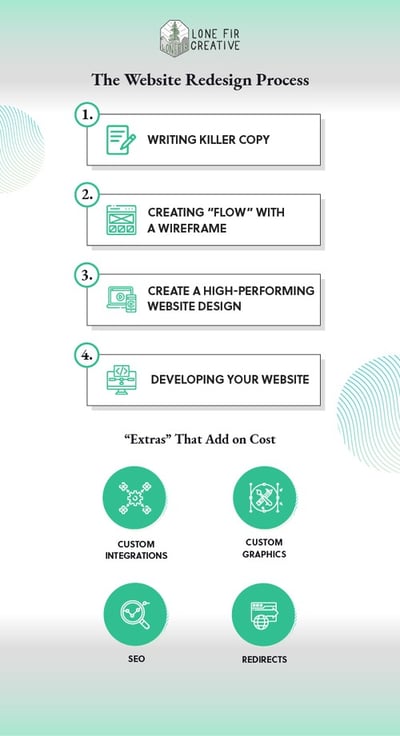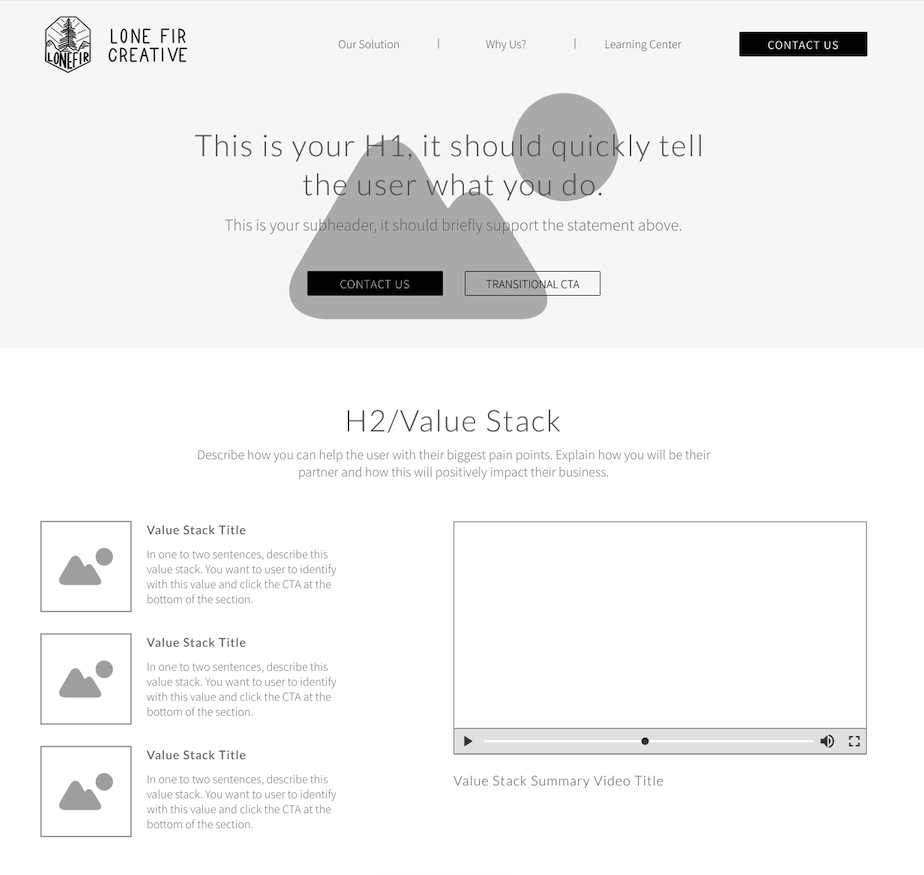Redesigning your website can be a blended recipe of emotions — half parts excitement, half parts frustration. The exciting aspect is easy and fun; it's the frustrating part that you seek answers to.
You might be asking yourself why it costs so much. Or maybe you’re concerned about the time you’re being told it takes to get a new website. We get these questions from potential customers pretty often, and rightfully so. It can be confusing when there are companies out there offering websites that cost much less and can launch much quicker. So why do some marketing agencies charge more than others?
The main factors that affect the cost and timeline of a website redesign are the process and “add-ons.” Each agency will approach the website redesign process differently. Those approaches always come with tradeoffs, and it’s essential to understand what those are. Add-ons are unique items added to your website’s functionality and current state. Let’s dig into these factors and how they apply to your business.
What We'll Cover:
- The Website Redesign Process
- "Extras" That Add Cost
- What Will Your Website Redesign Cost?
- Tying Your Website to Your Marketing Strategy
- Less Expensive Alternatives
The Website Redesign Process
Every website design process has four key phases for each page being designed: Copy, Wireframing, Design and Development. While each of these phases is a requirement for every new site, the approach to each of them will vary by company. We're going to walk through each phase, how we approach it and alternatives to our approach.

One obligatory note here: many companies require a sort of "Website Blueprint" before making any changes to their current site. This blueprint acts as a temperature check on your existing website and, in our experience, sets you up for success. It uses data from Google Analytics, your marketing platform and heat maps, if they are available, to create a website redesign strategy that is informed by data. While it requires more time upfront, it can lay the foundation for a more efficient and effective process down the road.
A Website Blueprint also sets a benchmark for the success of your website redesign project. Afterward, you can evaluate things like the bounce rate and conversion rate of key pages (assuming you have a marketing platform capable of tracking like HubSpot).
Now that we've gotten that public service announcement out of the way, let's move onto the major phases of a website redesign.
1. Writing Killer Copy
First up — copywriting. Some marketing agencies offer copywriting services for your website redesign, and some don’t. Some agencies may even require it as part of your package. While it may seem unnecessary to have an agency craft fresh copy for your website, you should understand the benefits.
We’ve found that many businesses think their biggest marketing problem is the design of their website when the root of the problem is usually the message they are communicating. Ask yourself this, does your target audience understand the service you offer the moment they hit your homepage? If not, your copy needs to be priority number one. Depending on your company, you may be up to the task of writing the copy yourself. This is a great way to save money on your website redesign, but comes with its own set of warning labels. The first being that you are so close to your brand, you may have some difficulty being objective enough to truly clarify your message. We’d recommend finding a company that offers a copywriting option. That way, if you’re short on time or hit a wall with your new copy, you have the option to bring in expert reinforcements.
Regarding the question of copy being a necessity for your new website before it’s designed, that's commonly debated. A concern might be how to write copy if you don’t know how much space you have to fill? And while that is a valid concern, it misses the point of having a website to begin with. Your website exists to sell to potential customers, and that's done with the words you use. The design, then, is intended to enhance that message, but you have to start with compelling copy.
“To avoid a “template-y” looking site, write your copy first. Once a designer has an understanding of the way the narrative is supposed to flow, they can provide the right visual support for the copy. If you design first, you get a template look because that’s the way you’re utilizing the design, not as support, but just a place to put the copy."
- Jessie-Lee Nichols, Creative Director at Lone Fir Creative
2. Creating “Flow” With a Wireframe
The next phase of a website redesign is building a “wireframe.” Not every agency does a formal wireframe, but at some point, you have to decide what you want on the page and how each section will flow. The wireframe, however it’s done, is meant to define that before it gets designed.
This is important because there’s a psychology to how your buyers understand your product. They need to know what you do before they know why they need your product. They need to understand why they need your product before they care about other people who love your product. We communicate each of these pieces differently depending on the characteristics of your target audience. Getting this "flow" hammered out before design saves a lot of time (and therefore money) because layout changes can have significant impacts on the design. It’s more economical to agree on those things in a highly editable document before it’s designed. A traditional wireframe might look something like this:

This is another piece where it’s helpful to have a skilled copywriter involved in the process. They can help tell your brand’s story on each of your website pages and make sure it’s both compelling and logical.
3. Create a High-Performing Website Design
And now for the design! For the most part, the design phase consists of a web designer creating a flat image or "mockup" of your page. Some agencies will combine this phase with development and design the website directly on your website platform. The advantage of this is that you can see how it looks live, and it saves time. The downside is that it takes a lot more effort (and money) to make changes to the design. That leaves a lot less room for feedback. If you’re looking for a lower-cost option, an agency that uses this approach might be right for you, just be aware of the constraints on design direction.
Two big things set a lot of web designers apart in this phase. The first is if they understand how to design for user experience and conversion. Having a flashy site is cool, but if website visitors don’t understand what you do and what you want them to do, they’re just going to leave your site without doing business with you.
The second differentiator is if the designer understands how to design for mobile devices. There was once a trend in the website world of building a desktop and mobile version of a website. These were essentially separate pages, each purpose-built for the device they are being viewed on. While you might see some sites still do this, most of the world has moved to a fully-responsive website design. That means that the design elements on your page adjust for the screen size.
But creating a good responsive website doesn’t start in development, it begins in design. An experienced designer understands how each element on the page will react to different screen sizes, and is designing in a way that looks good on desktop and converts well to a mobile screen
TL;DR: If you want a great website, hire a great designer.
4. Developing Your Website
After everyone settles on a design for your website, it gets developed. That means all of the code that makes your site look like the fancy design you’re now in love with gets written and implemented. Just like the design phase, there are a lot of behind the scenes things going on in development.
First, right before the design goes to development, the designer and developer will sit down and review the functionality of each element on the homepage. Things like a box dropping to 50% opacity when it’s not selected, or how a video should respond when you click on it (do you want it to pop up, play in a frame, or take you to another page?) There are a lot of little things that go into this phase that most people don't ever think of. And to risk boring you to death with this once again, that's why you should hire an experienced designer.
Once the developer has all that information, they get to work developing the site. The more complicated the site gets, the more it costs to develop.
📺 Check out our interview with our Website Project Manager for more about what goes into the process. 👇
“Extras” That Add on Cost
There are a few "extras" you will see in website packages that can begin to show up significantly in the cost. Some of these are unique to the functionality your site requires, some are results of your past website designs, and others are performance related.
- SEO: SEO or "search engine optimization" is nearly endless in the number of things you can improve on your website. Our websites include optimization for "branded search," but many companies tie in service or product-specific keywords into their website redesign. This can be really effective, but it all depends on your product, website traffic and budget. We always use SEO best practices in building a new website, but SEO is a long term strategy not a one and done tactic.
- Custom Graphics: This term often means one of two things. Vector images can be "customized" with your company's colors, or rearranged to fit the purpose of the page. But if you're looking for an illustration that is brand new and unique to your company, that is a separate service that most companies will charge an additional fee to complete. This is because that kind of graphics work needs an Illustrator, which is a separate set of skills from the person you hire to design your website.
- Custom Integrations: Some integrations will come standard in your website package. But as they become more complicated and labor intensive, they will require more development time, which will be added to the scope of the project. A custom integration could be anything from sharing user behavior on your site to a customer record on your CRM or adding an online shop to your site.
- Redirects: If your website has been through several different redesigns and platform changes, you could have hundreds or thousands of URLs that need to be addressed in your redesign. This will be unique to your website and should be addressed when your project is scoped out.
- Website Hosting: Depending on what platform you're building your website on, there may be an extra cost to host the website. (Learn more about what web hosting is.)
- Room for Feedback: This isn't so much an extra as a major variable between companies that work on website redesign projects. Depending on how your contract is set up, there is bound to be some kind of limit on revisions. While that might sound a bit off-putting, it's a safeguard to the cycle of endless tweaks that website designs can easily suffer from. There's a balance here to making sure that all decision-makers are satisfied while acknowledging that things like design are somewhat subjective. What we're trying to say here is, there are always a lot of opinions on a website redesign. If you want to be super successful, designate one person as the final decision maker and make sure they are involved throughout the entire process.
What Will Your Website Redesign Cost?
The average cost of a website redesign can vary significantly based on the site requirements, the number of pages, and the agency that you hire. Depending on the team you choose, they may also include strategy or messaging in their website redesign process.
At Lone Fir Creative, you can expect a website redesign to start around $20k for a typical site with five or more webpages of content, designed and developed. We also include a Messaging Workshop and Website Blueprint in that pricing to make sure your website will be effective for your target audience. After all, your website is just some pretty colors and shapes if it's not built to convert your specific audience into leads.
What the Heck is a Website Blueprint?
A Website Blueprint is a tool used by many agencies to gather data and build an informed plan for your website redesign. This will include some level of competitor and SEO research and allows the agency the time and resources to present a website redesign strategy that not only makes your eyes happy but also helps you make progress towards your business goals.
At Lone Fir Creative, a Website Blueprint costs $3,500 and takes 30 days to complete. But once you're done, you'll be set up for a successful redesign. Here's what our Website Blueprint includes:
- A broad overview of historic website performance.
- An overview of SEO performance on your current site.
- Broad competitor research to inform your new site's visual presenting and messaging.
- Copy Audit of your primary website pages to identify gaps, lack of alignment with your Brand Messaging and flow of the content.
- A homepage wireframe to lay out the best user flow.
- Three design comps for the first two sections of your website to determine a direction for design.
- Recommendations for website redesign and supporting assets to meet the business goals you have presented.
Website Blueprints not only set your site up for success with your target audience, they also allow agencies to more accurately scope your project, minimizing surprises along the way.
Tying Your Website to Your Marketing Strategy
The number one difference between a “marketing agency” and a company or individual that just builds websites will be the integration of your marketing strategy into your website design. When you hire a marketing agency, you’re hiring expert team members with experience in helping businesses build cohesive marketing assets that answer key business needs. When you hire an individual or agency that just does website design, they are only involved in that portion of your marketing strategy, and they often don’t have expertise outside of website work. Even if you hire a marketing agency just to redesign your site, you get the benefit of having people that understand your funnel and can make sure that the user experience aligns with your business goals.
This undoubtedly adds to the overall cost, but it removes the burden of being a strategist, marketer, skilled copywriter and expert in the variables of web design and development from your shoulders. When you hire a marketing agency, no matter their process, you’re hiring a team of people with expertise in each of those areas.
Less Expensive Alternatives
By now, it is (hopefully) more clear why a new website can cost so much and take so long to launch. And maybe the justification for the cost is there, but there still isn’t a justification for your business to spend that much money on a website. We get that. Not every company is at a stage where spending that kind of money makes sense. So what can you do?
Fortunately, there are plenty of other options out there. Here are a few that could help:
- Use WordPress and purchase a theme. A theme is a template that has been designed and developed and is available to purchase for your website. Then all you have to do is add your content and voila! You have a snazzy new website. The other advantage to WordPress for DIY website designers is the number of plugins available to you to solve for features you may need or want. Here’s a step-by-step guide for getting set up on WordPress.
- Use Squarespace.If you’re a bit less digitally savvy but aren’t scared off by the idea of launching your own website, Squarespace is a great option. Best known for its user-friendly interface, Squarespace can help you build a website without a designer or developer, and is a little less technical than WordPress. Check them out here.
- Find a company that specializes in low-cost websites. While it's not the cheapest option in comparison to the do-it-yourself platforms, there are a lot of companies out there that will build a website for less money than we do. This can be a great first step for small business owners who aren't ready to invest a ton into their website design. If your site is simple and you don’t need anything else other than a place for your brand to live in the digital space, this could be a good place to start.
- Hire a freelancer. There are freelancers out there that design and build websites, often on WordPress themes and with minimum customization.
In case you haven't received our not-so-subtle hints yet, we help companies strategically redesign their websites. So if you have any questions about redesigning your website, free to schedule a strategy call right here. We’d love to help.






